A Municipality-Based Approach Using Commuting Census Data to Characterize the Vulnerability to Influenza-Like Epidemic: The COVID-19 Application in Italy
Abstract
:1. Introduction
2. Materials and Methods
2.1. Demography and Commuting Network
2.2. SI Model to Evaluate the COVID-19 Spread Dynamics
2.2.1. Theoretical Geodemography Framework
2.2.2. Model Implementation
Infection Contact Rate Parameter Modeling
Model Simulation Scenarios
| Algorithm 1 The pseudo model algorithm |
| #constants shared between scenarios |
| K = 10 |
| #constants within scenario |
| SIM (number of simulation) |
| Deep (number of days to be simulated) |
| NTW (Commuting network: weighted links among municipalities of the corresponding scenario) |
| I (number of officially infected) |
| For each simulation |
| Sample infected according to scenario |
| For each day |
| If during weekend, switch the correspondence between active period and population |
| For each sub-day period |
| For each infected municipality |
| find new infected according to ODE equations |
| End |
3. Results
3.1. Analysis of the Commuting Network
3.2. Infection Contact Rate Parameter Estimation
3.3. SI Model to Evaluate the COVID-19 Spread Dynamics
3.3.1. Scenario 1
3.3.2. Scenario 2
3.3.3. Scenario 3
4. Discussion and Conclusions
Author Contributions
Funding
Conflicts of Interest
References
- World Health Organization. Coronavirus Disease (COVID-2019) Situation Report. 2020. Available online: https://www.who.int/docs/default-source/coronaviruse/situation-reports/20200121-sitrep-1-2019-ncov.pdf?sfvrsn%20=%2020a99c10_4 (accessed on 16 June 2020).
- Fisher, D.; Wilder-Smith, A. The global community needs to swiftly ramp up the response to contain COVID-19. Lancet Lond. Engl. 2020, 395, 1109–1110. [Google Scholar] [CrossRef]
- Sjödin, H.; Wilder-Smith, A.; Osman, S.; Farooq, Z.; Rocklöv, J. Only strict quarantine measures can curb the coronavirus disease (COVID-19) outbreak in Italy, 2020. Euro Surveill. 2020, 25, 2000280. [Google Scholar] [CrossRef]
- Giordano, G.; Blanchini, F.; Bruno, R.; Colaneri, P.; Di Filippo, A.; Di Matteo, A.; Colaneri, M. Modelling the COVID-19 epidemic and implementation of population-wide interventions in Italy. Nat. Med. 2020, 1–6. [Google Scholar] [CrossRef]
- Khan, K.; Arino, J.; Hu, W.; Raposo, P.; Sears, J.; Calderon, F.; Heidebrecht, C.; Macdonald, M.; Liauw, J.; Chan, A.; et al. Spread of a Novel Influenza A (H1N1) Virus via Global Airline Transportation. N. Engl. J. Med. 2009, 361, 212–214. [Google Scholar] [CrossRef] [PubMed]
- Colizza, V.; Barrat, A.; Barthélemy, M.; Vespignani, A. Predictability and epidemic pathways in global outbreaks of infectious diseases: The SARS case study. BMC Med. 2007, 5, 34. [Google Scholar] [CrossRef]
- Alamo, T.; Reina, D.G.; Mammarella, M.; Abella, A. Covid-19 Open-Data Resources for Monitoring, Modeling and Forecasting the Epidemic. Electronics 2020, 9, 827. [Google Scholar] [CrossRef]
- Vollmer, M.A.C.; Mishra, S.; Unwin, H.J.T.; Gandy, A.; Melan, T.A.; Bradley, V.; Zhu, H.; Coupland, H.; Hawryluk, I.; Hutchinson, M.; et al. Report 20: A sub-national analysis of the rate of transmission of Covid-19 in Italy. Imp. Coll. Lond. 2020. [Google Scholar] [CrossRef]
- Oliver, N.; Lepri, B.; Sterly, H.; Lambiotte, R.; Delataille, S.; De Nadai, M.; Letouzé, E.; Ali Salah, A.; Benjamins, R.; Cattuto, C.; et al. Mobile phone data for informing public health actions across the COVID-19 pandemic life cycle. Sci. Adv. 2020. [Google Scholar] [CrossRef]
- Merler, S.; Ajelli, M. Human mobility and population heterogeneity in the spread of an epidemic. Procedia Comput. Sci. 2010, 1, 2237–2244. [Google Scholar] [CrossRef] [Green Version]
- Ajelli, M.; Gonçalves, B.; Balcan, D.; Colizza, V.; Hu, H.; Ramasco, J.J.; Merler, S.; Vespignaniet, A. Comparing large-scale computational approaches to epidemic modeling: Agent-based versus structured metapopulation models. BMC Infect. Dis. 2010, 10, 190. [Google Scholar] [CrossRef] [Green Version]
- Gatto, M.; Bertuzzo, E.; Mari, L.; Miccoli, S.; Carraro, L.; Casagrandi, R.; Rinaldo, A. Spread and dynamics of the COVID-19 epidemic in Italy: Effects of emergency containment measures. Proc. Natl. Acad. Sci. USA 2020, 117, 10484–10491. [Google Scholar] [CrossRef] [PubMed] [Green Version]
- ISTAT. Matrici del Pendolarismo: I Dati dei Residenti Rilevati dal 15° Censimento della Popolazione che si Spostano tra Comuni o all’interno dello Stesso per Motivi di Lavoro o di Studio; 19 Nov 2014 [cited 7 May 2020]; Istituto Nazionale di Statistica: Roma, Italy, 2014 7 May; Available online: https://www.istat.it/it/archivio/139381.
- Dipartimento Protezione Civile. Protezione Civile. COVID-19 Italia - Monitoraggio Situazione. Contribute to pcm-dpc/COVID-19 Development by Creating an Account on GitHub. GitHub [Internet]. [cited 7 May 2020]. Available online: https://github.com/pcm-dpc/COVID-19 (accessed on 16 June 2020).
- Pastor-Satorras, R.; Vespignani, A. Epidemic Spreading in Scale-Free Networks. Phys. Rev. Lett. 2001, 86, 3200. [Google Scholar] [CrossRef] [PubMed] [Green Version]
- Dubé, C.; Ribble, C.; Kelton, D.; McNab, B. Introduction to network analysis and its implications for animal disease modelling. Rev. Sci Tech. Int. Epiz. 2011, 30, 425–436. [Google Scholar]
- Martínez-López, B.; Perez, A.M.; Sánchez-Vizcaíno, J.M. Social Network Analysis. Review of General Concepts and Use in Preventive Veterinary Medicine. Transbound. Emerg. Dis. 2009, 56, 109–120. [Google Scholar] [CrossRef]
- Candeloro, L.; Savini, L.; Conte, A. A New Weighted Degree Centrality Measure: The Application in an Animal Disease Epidemic. PLoS ONE 2016, 11, e0165781. [Google Scholar] [CrossRef]
- Remuzzi, A.; Remuzzi, G. COVID-19 and Italy: What next? Lancet 2020, 395, 1225–1228. [Google Scholar] [CrossRef]
- Villa, M. ISPI analysis: Covid-19 and Italy’s Case Fatality Rate: What’s the Catch? 27 Mar 2020 [cited 8 May 2020]. Available online: https://www.ispionline.it/en/publication/covid-19-and-italys-case-fatality-rate-whats-catch-25586 (accessed on 16 June 2020).
- Ooi, H.; Corporation, M.; Weston, S.; Tenenbaum, D. doParallel: Foreach Parallel Adaptor for the “parallel” Package. 2019. Available online: https://CRAN.R-project.org/package%20=%20doParallel (accessed on 16 June 2020).
- Pebesma, E.; Bivand, R.; Rowlingson, B.; Gomez-Rubio, V.; Hijmans, R.; Sumner, M.; MacQueen, D.; Lemon, J.; O’Brien, J.; O’Rourke, J. Classes and Methods for Spatial Data. 2018. Available online: https://CRAN.R-project.org/package%20=%20sp (accessed on 16 June 2020).
- Kahle, D.; Wickham, H.; Jackson, S.; Korpela, M. ggmap: Spatial Visualization with ggplot2. 2019. Available online: https://CRAN.R-project.org/package%20=%20ggmap (accessed on 16 June 2020).
- Anselin, L. Local Indicators of Spatial Association-LISA. Geogr. Anal. 2010, 27, 93–115. [Google Scholar] [CrossRef]
- Balcan, D.; Colizza, V.; Goncalves, B.; Hu, H.; Ramasco, J.J.; Vespignani, A. Multiscale mobility networks and the spatial spreading of infectious diseases. Proc. Natl. Acad. Sci. USA 2009, 106, 21484–21489. [Google Scholar] [CrossRef] [Green Version]
- Findlater, A.; Bogoch, I.I. Human Mobility and the Global Spread of Infectious Diseases: A Focus on Air Travel. Trends Parasitol. 2018, 34, 772–783. [Google Scholar] [CrossRef]
- Charaudeau, S.; Pakdaman, K.; Boëlle, P.-Y. Commuter Mobility and the Spread of Infectious Diseases: Application to Influenza in France. PLoS ONE 2014, 9, e83002. [Google Scholar] [CrossRef] [Green Version]
- Huang, C.-Y.; Chin, W.-C.-B.; Wen, T.-H.; Fu, Y.-H.; Tsai, Y.-S. EpiRank: Modeling Bidirectional Disease Spread in Asymmetric Commuting Networks. Sci. Rep. 2019, 9, 5415. [Google Scholar] [CrossRef] [PubMed] [Green Version]
- Tizzoni, M.; Bajardi, P.; Decuyper, A.; Kon Kam King, G.; Schneider, C.M.; Blondel, V.; Smoreda, Z.; González, M.C.; Colizza, V. On the Use of Human Mobility Proxies for Modeling Epidemics. Salathé, M., editor. PLoS Comput. Biol. 2014, 10, e1003716. [Google Scholar] [CrossRef] [PubMed] [Green Version]
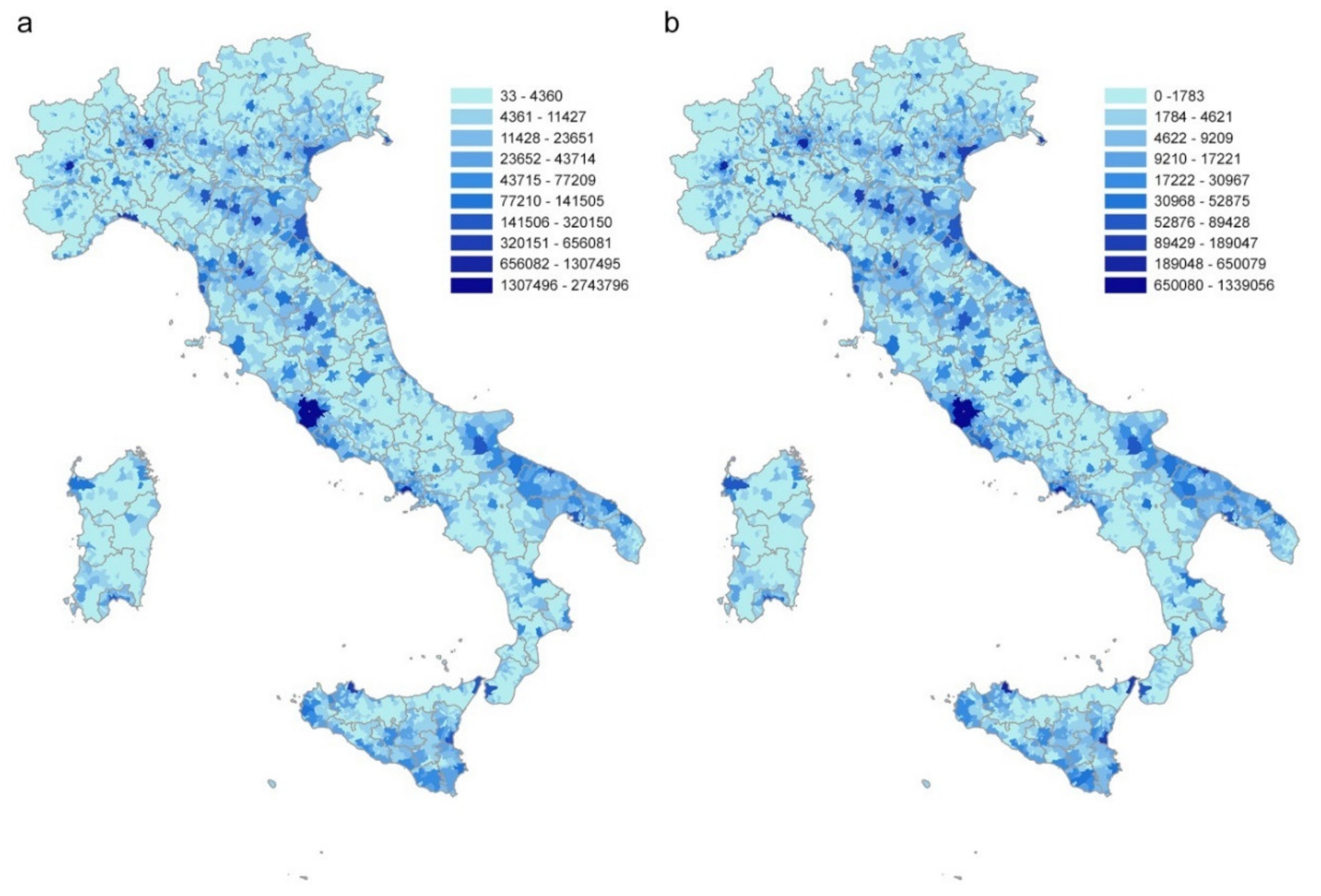

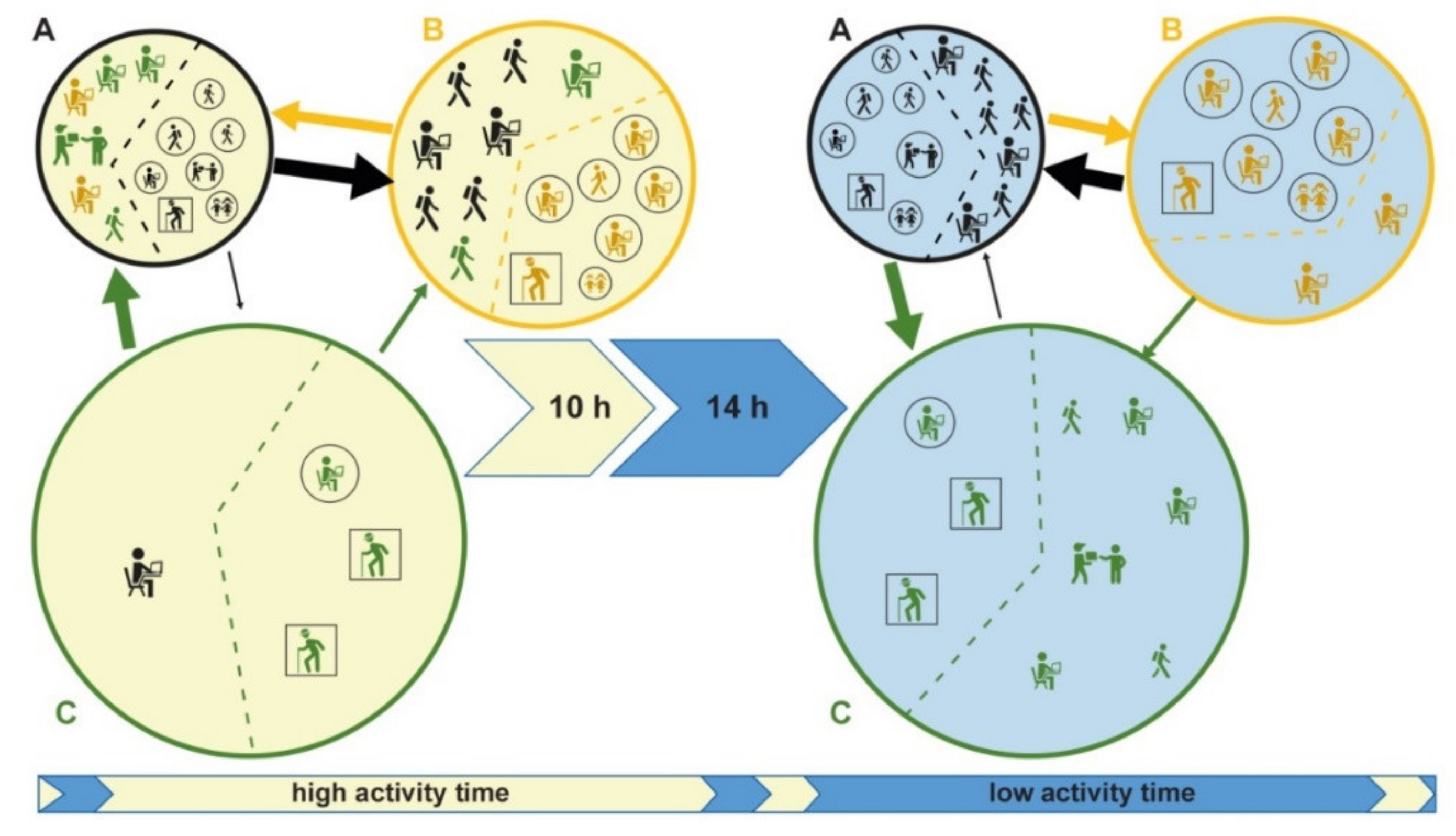
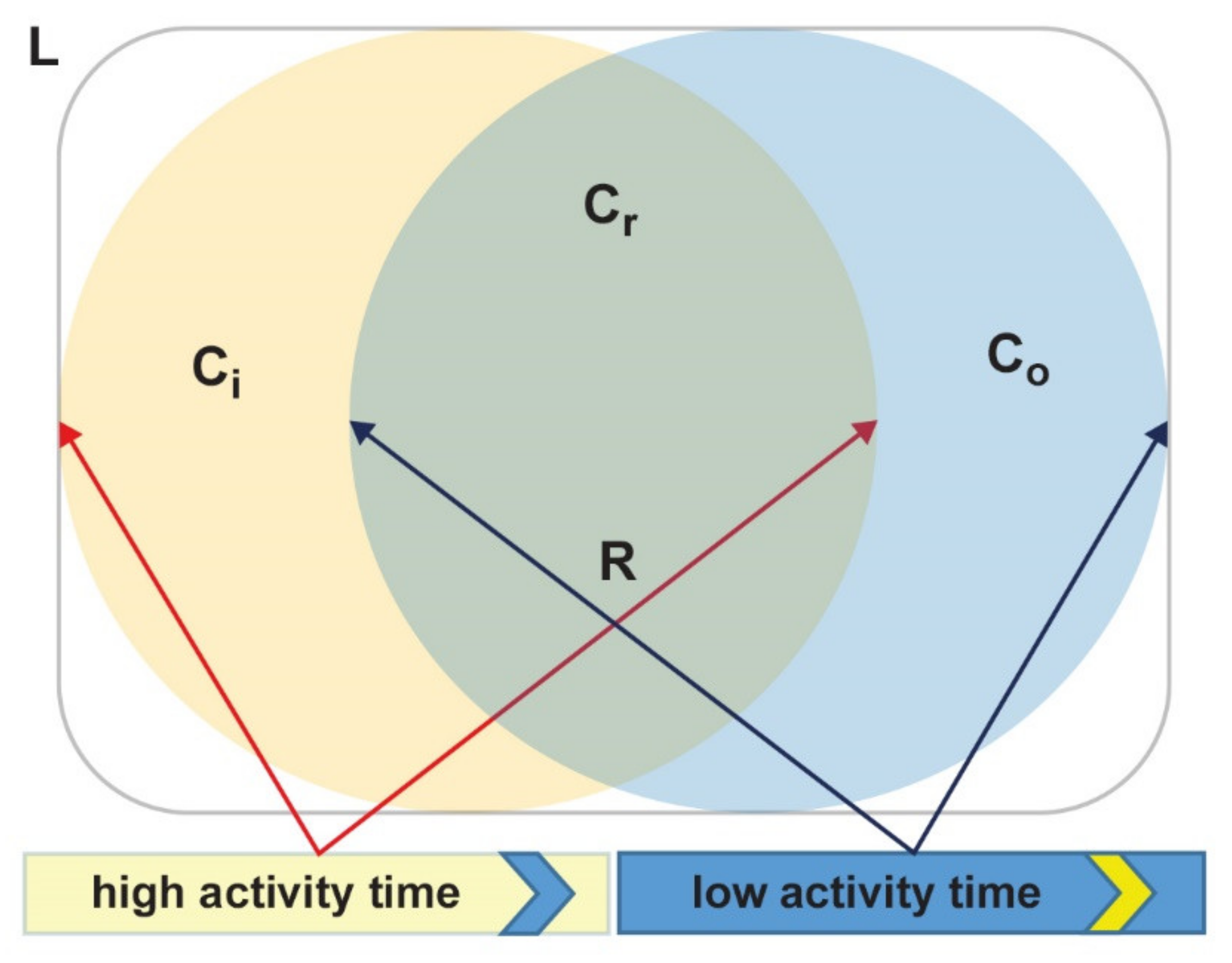
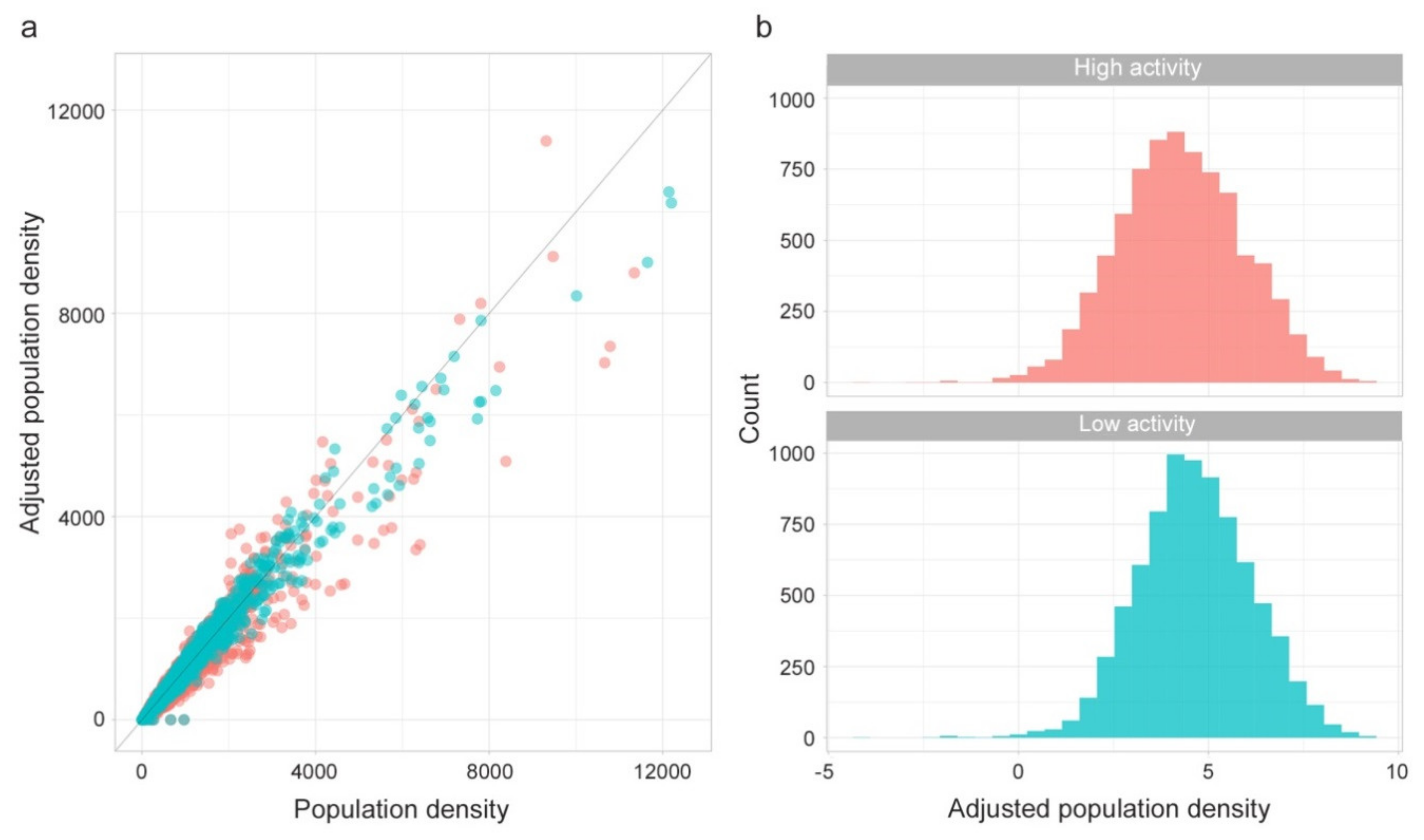
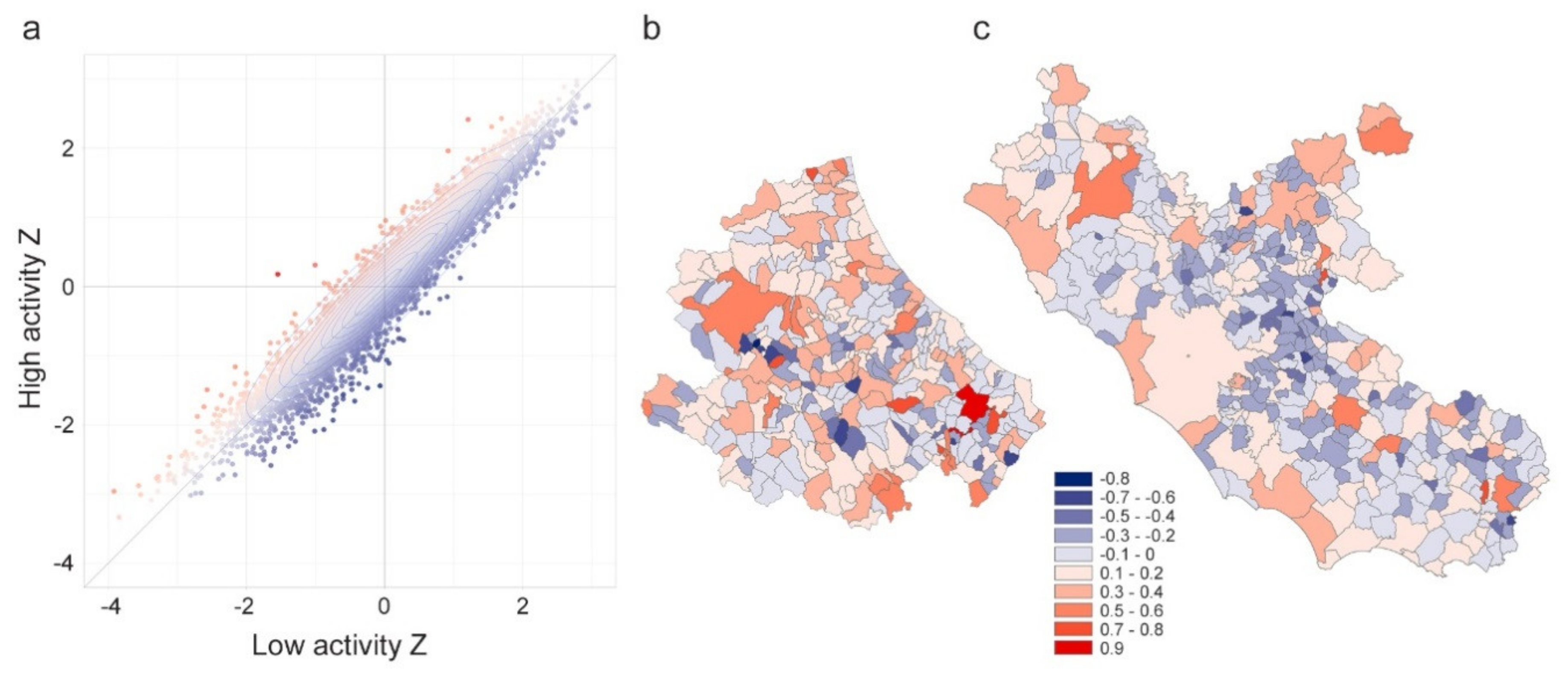
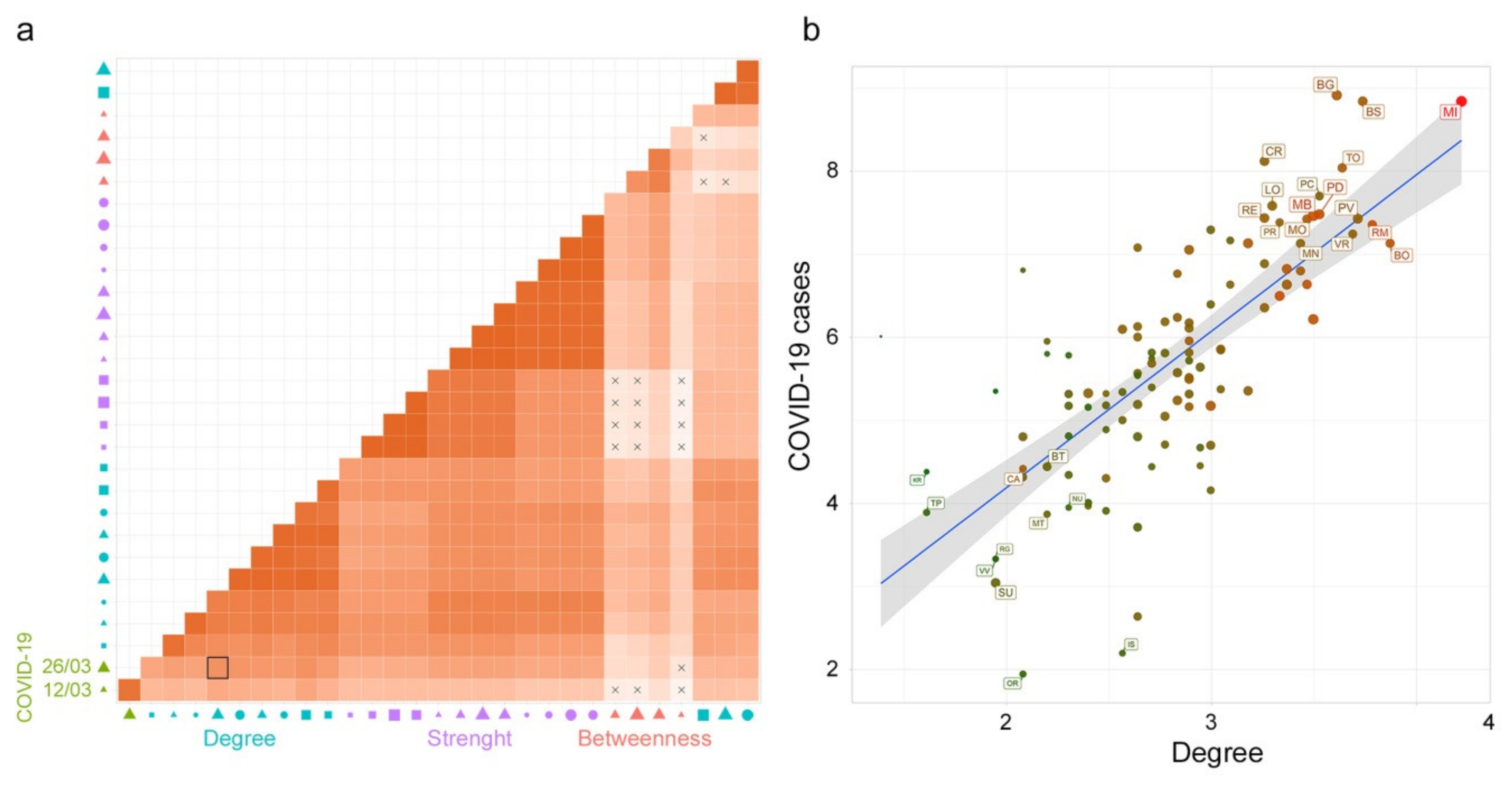


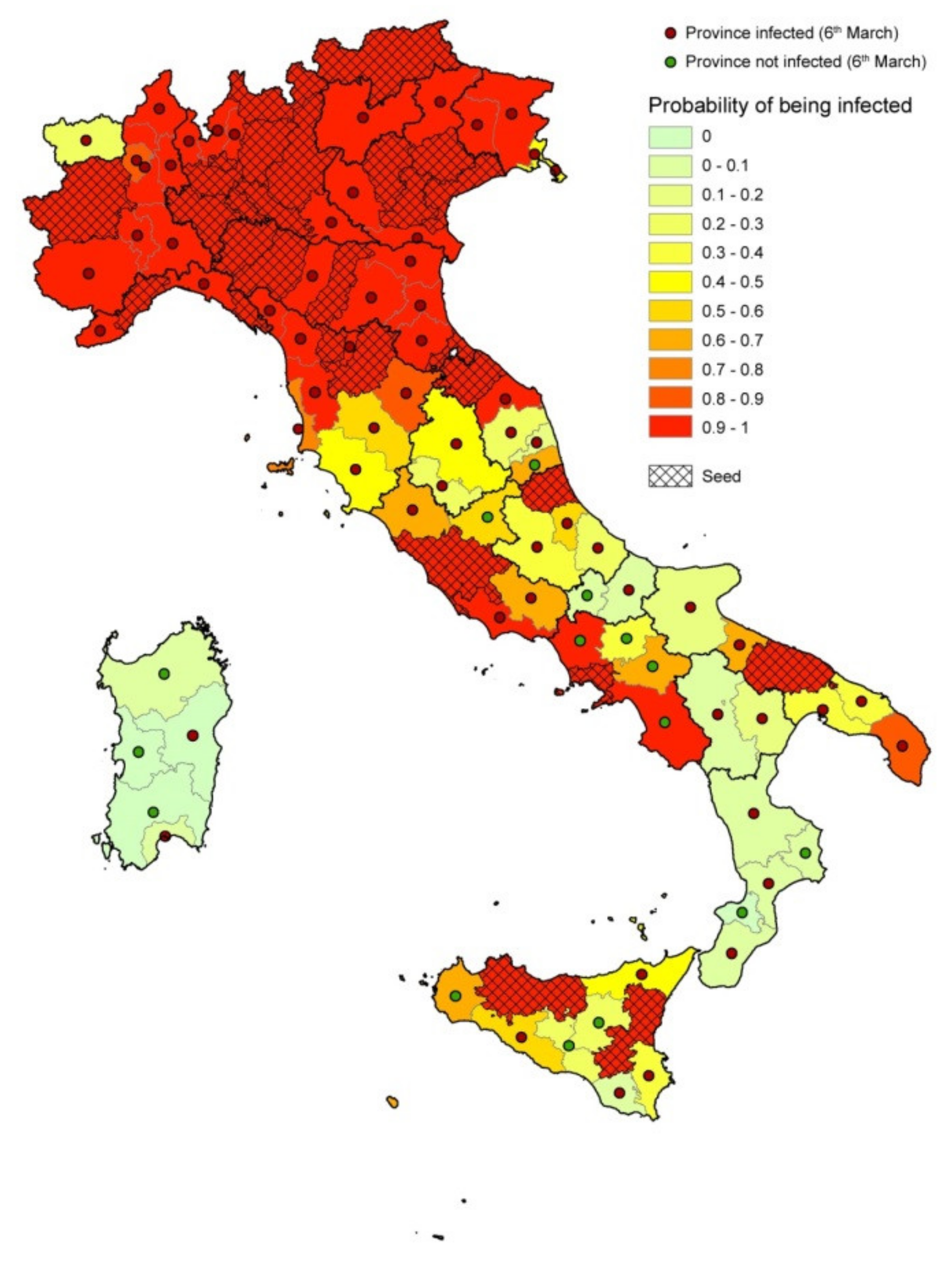

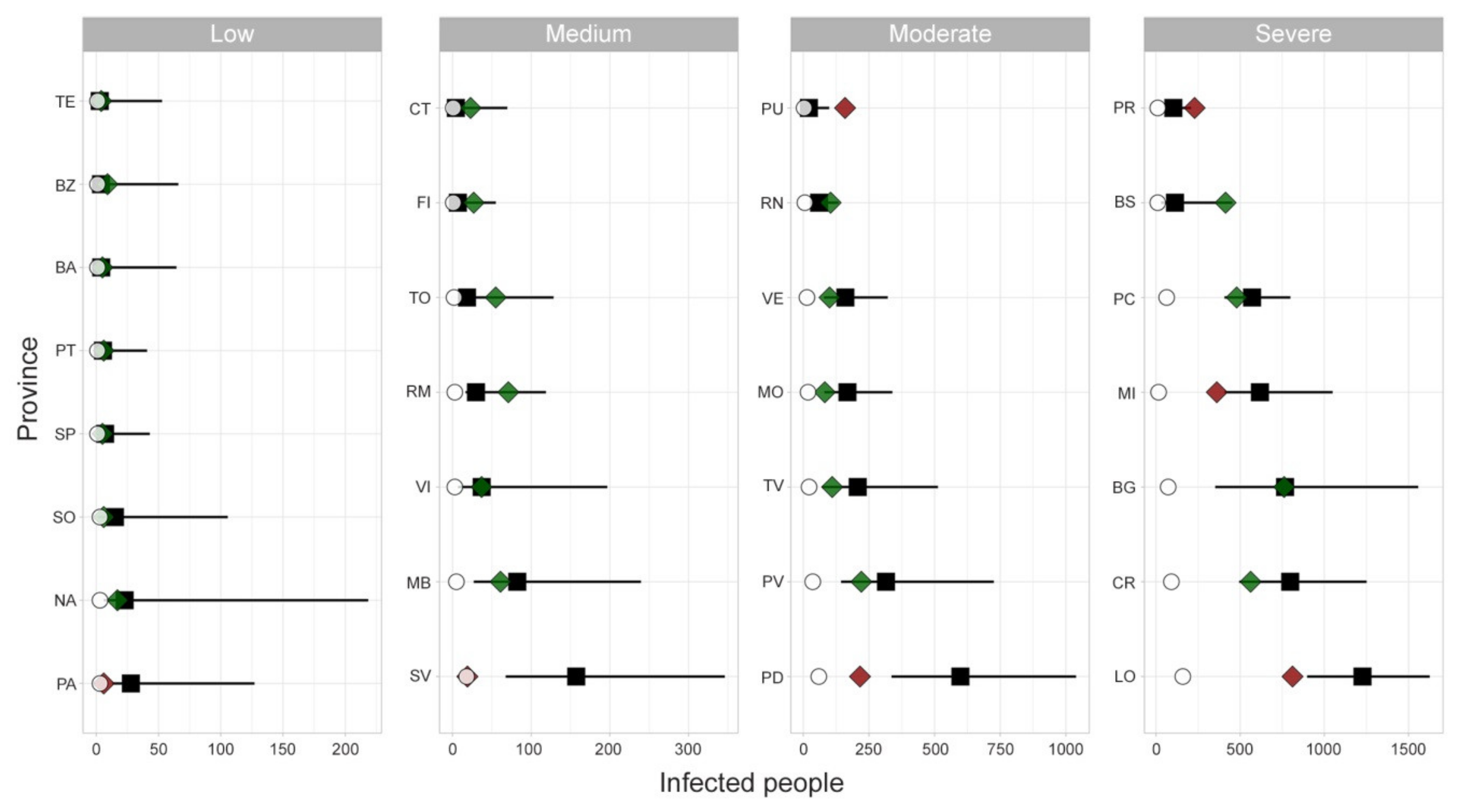
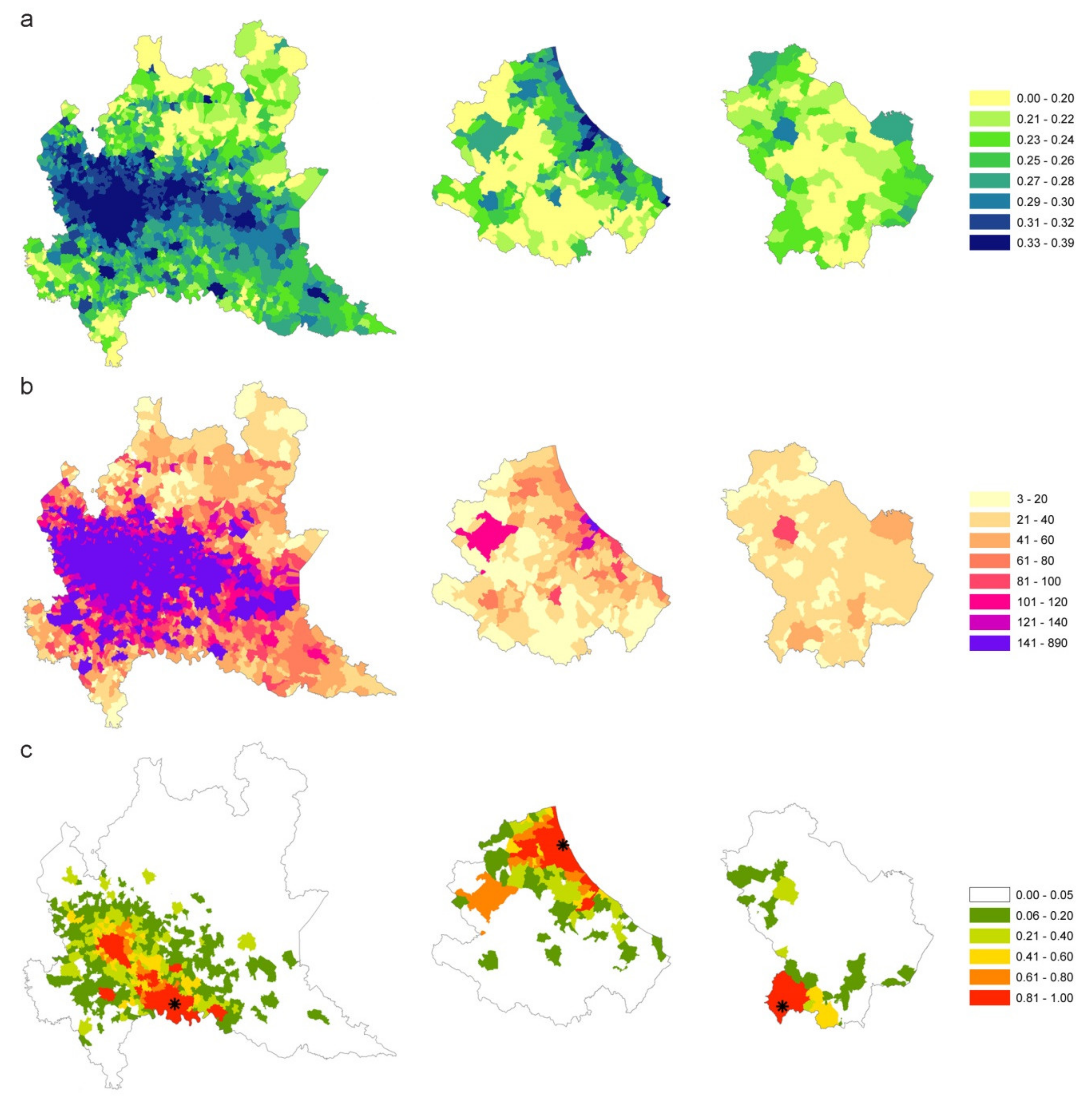


| Scenario | Num. of Simulation | Num. of Simulation Runs | Deep in Day | Region | Scale Resolution | Seed (t0) | I(t0) |
|---|---|---|---|---|---|---|---|
| Scenario 1 | 1 | 500 | 10 | Italy | Municipality | Randomly distributed inside the initial infected provinces (29) | Observed cases as of February 26 = 625 |
| Scenario 2 | 1 | 500 | 21 | Lombardy | Municipality | Codogno | 1 |
| Abruzzi | Roseto Degli Abruzzi | ||||||
| Basilicata | Trecchina | ||||||
| Scenario 3 | 305 | 500 | 14 | Abruzzi | Municipality | All municipalities (305) | 1 |
© 2020 by the authors. Licensee MDPI, Basel, Switzerland. This article is an open access article distributed under the terms and conditions of the Creative Commons Attribution (CC BY) license (http://creativecommons.org/licenses/by/4.0/).
Share and Cite
Savini, L.; Candeloro, L.; Calistri, P.; Conte, A. A Municipality-Based Approach Using Commuting Census Data to Characterize the Vulnerability to Influenza-Like Epidemic: The COVID-19 Application in Italy. Microorganisms 2020, 8, 911. https://doi.org/10.3390/microorganisms8060911
Savini L, Candeloro L, Calistri P, Conte A. A Municipality-Based Approach Using Commuting Census Data to Characterize the Vulnerability to Influenza-Like Epidemic: The COVID-19 Application in Italy. Microorganisms. 2020; 8(6):911. https://doi.org/10.3390/microorganisms8060911
Chicago/Turabian StyleSavini, Lara, Luca Candeloro, Paolo Calistri, and Annamaria Conte. 2020. "A Municipality-Based Approach Using Commuting Census Data to Characterize the Vulnerability to Influenza-Like Epidemic: The COVID-19 Application in Italy" Microorganisms 8, no. 6: 911. https://doi.org/10.3390/microorganisms8060911
APA StyleSavini, L., Candeloro, L., Calistri, P., & Conte, A. (2020). A Municipality-Based Approach Using Commuting Census Data to Characterize the Vulnerability to Influenza-Like Epidemic: The COVID-19 Application in Italy. Microorganisms, 8(6), 911. https://doi.org/10.3390/microorganisms8060911






